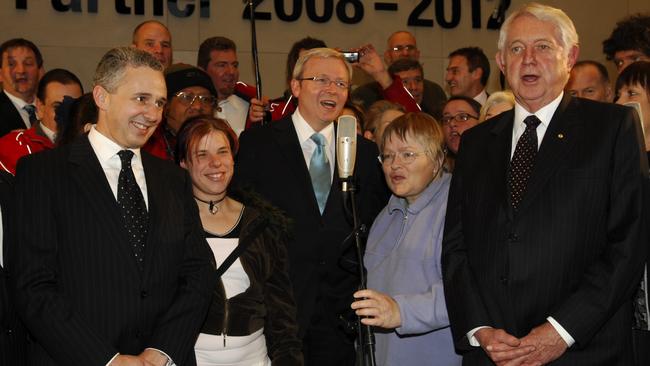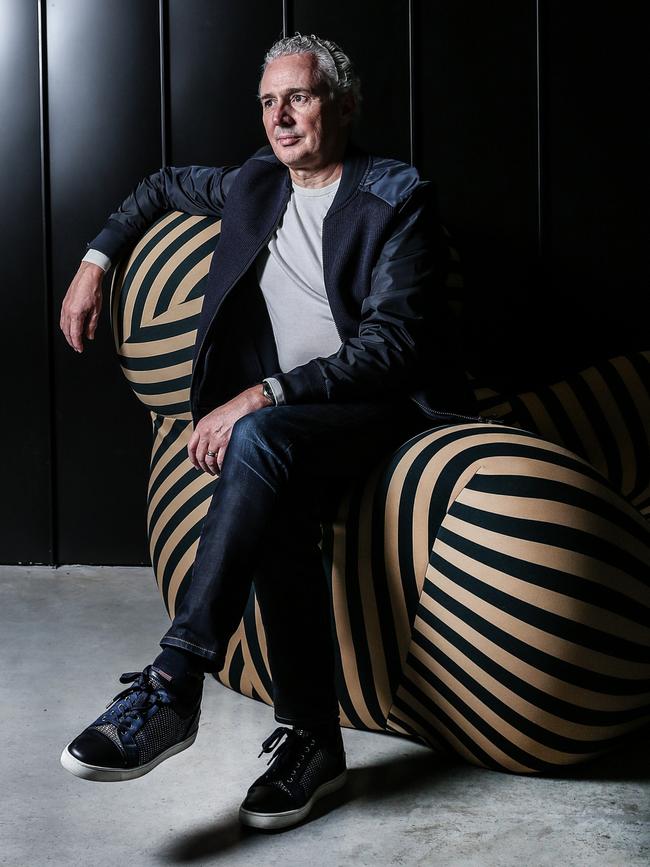Last call: outgoing Telstra boss Andy Penn ponders his legacy
He stepped down after a tumultuous seven years at the helm of Telstra. How does Andy Penn feel about it now – and how do his adversaries see him?

On Andy Penn’s living room wall, alongside landscapes by Tim Storrier and Arthur Boyd, hangs a large abstract painting of a Telstra payphone box, purple and illuminated in the night sky. The outgoing Telstra chief executive is an avid art collector and his inner Melbourne home could be accurately described as one of the city’s best private art galleries, housing more than 300 works from abstract landscapes to digital works powered by artificial intelligence. But that Telstra painting will hold a special place for Penn, a reminder of one of the most turbulent and challenging periods of his career.
Seven years after taking on one of corporate Australia’s highest-profile, highest-paid, perhaps least-enviable jobs, 58-year-old Penn has made for the exit. Upon announcing his departure from Telstra in March, he was approached by Australia’s big four banks about taking a senior role but rebuffed each of them. In his final interview before his departure, Penn reveals he is ruling out another full-time executive role. He wants to take back some control over his life. “I want to continue to make an impact but do that through a portfolio of things,” he says. “The stuff I enjoy doing is supporting the government policy on cybersecurity and critical technologies, and I’ll continue to do that, and supporting the visual arts. And we are passionate about Melbourne and Victoria, so we’ll be helping support transition of the city of Melbourne from the impact of Covid too. It’ll be nothing full-time, and not one single ticket thing.”
British-born Penn is at ease in his home, a brutalist Prahran warehouse conversion, and seems more relaxed than in any of our previous encounters over the years. His Nebraska-born wife Kallie Blauhorn is making pastrami sandwiches while their dogs Mr Bennett and Wolsely watch on. The couple’s love of art collecting is in evidence: Tim Storrier probably never thought his 1996 epic landscape painting Evening Embers would share wall space with teamLab’s computer-generated video artwork Universe of Water Particles Gold, but for Penn the combination makes sense.
“It’s mixed emotions,” Penn says, coming back to his departure. “I wake up in the morning and when I read the paper there’s virtually nothing in there which I can’t connect to what Telstra is doing in some way, whether it’s cybersecurity or a bushfire or a new piece of innovation, and one of the incredible privileges of Telstra is it touches every Australian and every community.” In turn, almost every Australian has an opinion of Telstra. Many are shareholders either directly or through their superannuation funds, and many have also either suffered through one of the telco’s mobile outages, had a poor offshore call centre experience, or relied on the company’s networks to stay online and connected, particularly during raging bushfires and pandemic lockdowns.
A perennial comeback kid, Penn dropped outof high school at the age of 15 to work as a shipping clerk for P&O. He describes his professional career as consisting of three acts. He came to Australia from Britain in 1992 when his then employer National Mutual asked him to move to Melbourne. National Mutual would later become AXA Asia Pacific and Penn was forced to step aside as the boss of the insurer in 2005 after the financial regulator found that he and other trustee directors had made changes to the staff superannuation fund without consulting members. That ruling was later overturned by the Administrative Appeals Tribunal, which admonished APRA and its original findings. Penn was reinstated in August 2006, promoted to CEO in October that year and didn’t look back. Over two decades Penn grew AXA’s Australian and Asia arms into billion-dollar insurance behemoths.
These run-ins with the regulator and subsequent media firestorms at AXA would prove sound preparation for later tussles at Telstra, which Penn has transformed in the face of heavy scrutiny into a leaner, more nimble telco, while retaining its dominant market position. “One thing that’s always stayed with me is the importance of continuing to learn,” Penn says. “That was borne out of my very early history of not doing well at school, and ever since I’ve just had a strong appetite to learn new things, and the decision to move to Telstra was sort of drinking from the firehose initially.”
When he first joined Telstra as chief financial officer in 2012, Penn knew little about the industry and faced a steep learning curve. His appointment surprised industry insiders who wondered why the financial services veteran would want to join a telco. By the time he took the top job in May 2015 the telco’s share price was sitting pretty at $6.50, bolstered by a period of strong growth under then-CEO David Thodey, still one of Australia’s most highly regarded executives. The company was paying handsome dividends, having not yet felt the multi-billion dollar destruction in value wrought by the National Broadband Network.

The NBN was a project that graduated from a drawing on a napkin on Kevin Rudd’s prime ministerial jet into a nationwide infrastructure project that served not only as a political football – and still does – but also a sore point for executives across the telecommunications industry who, more than a decade on, still complain about its business model.
In creating the NBN, the government effectively forced Telstra to give up control of its broadband network and all of the associated profits. Penn says he originally thought the NBN would provide some upside for Telstra, given the billions of dollars in payments from NBN Co to rent infrastructure and pay for the disconnection and migration of customers. But despite the short-term sugar hit, NBN’s impact ultimately cost Telstra $3.6 billion in annualised profits and led the company to eventually axe thousands of staff.
Penn now describes the project’s formation as a “sledgehammer approach” and doesn’t disagree with the notion that Australia would have been better off without it. He thinks its objectives, while important, could have been achieved faster and more cheaply without the intervention. Penn gets animated talking about the issue. “I don’t think, ultimately, you want the government to be the long-term provider of wholesale fixed broadband in this country and I think both sides of government actually agree with that,” he says. “There’s no doubt that we did not fully internalise and embrace the true consequences of what the NBN would mean. I don’t completely absolve myself from accountability, because I was around… But by not being more proactive in communicating what the significant economic headwinds to Telstra would be, there was then this expectation that we would find other sources of income or just smooth it all out. And clearly with the benefit of hindsight, that was never going to be the case.”
Penn’s legacy at Telstra will perhaps be most closely tied to his aggressive so-called “T22” cost-cutting strategy first announced in 2018, in which the telco slashed about a third of its workforce – some 10,000 employees – and cut its mobile plans from about 1800 to 20, as well as splitting the Telstra parent company into four different entities to make them more attractive to investors.
Firing your employees is never easy so Penn prefers to thinks of the bigger picture. “I think what I’ve found with people is that as long as you’re open, honest and transparent, and treat people fairly, then you can make those decisions and people understand and respect them,” he says. “If you step back from it, there’s a lot of noise but the bigger picture is actually relatively simple. The government made a policy decision to create the NBN for the purpose of taking over the wholesale business, what did people think was going to happen? That we would just continue to employ the same number of people doesn’t make any sense at all.”
Faced with those NBN pains that brought with them billions of dollars in lost shareholder value, combined with multiple network outages along with at times plunging consumer, board and investor confidence, Penn wasn’t always a sure thing to remain in the top job. The coronavirus pandemic added to the challenge as the work-from-home mandate tested internet reliability across the nation.

Penn adapted quickly to working remotely, sharing his time between his Prahran warehouse and a residence in Red Hill on the Mornington Peninsula. He still often works remotely in a small home office he shares with Blauhorn, chair of the Monash Gallery of Art and a board member of the Melbourne Fashion Festival and St Vincent’s Institute of Medical Research. “It’s made me realise he has more EQ than I’d thought,” Blauhorn says of their office-sharing arrangement.
While a keen painter and fly fisher, Penn is by all accounts a workaholic but says he doesn’t feel the need to switch off. “It’s a great responsibility, but it’s not a burden,” he says of being in charge at Telstra. “I don’t feel that desperate need to go and do something else, to go and read or write to recharge or whatever. But I do enjoy painting, and having a bit more balance in my life, I love the visual arts and getting involved in that from a philanthropic point of view.”
Running a national institution is an inherently high-pressure responsibility and one person who knows that more intimately than most is Stephen Elop, the first non-Finnish CEO of perhaps Finland’s most famous export, Nokia. Elop, a Canadian, joined Telstra as its executive in charge of technology, innovation and strategy in April 2016 and was at the company for two years, quickly learning the intense public and media scrutiny that came with the position. He was a key architect of the T22 strategy.
“Andy understood the role that Telstra played in the national psyche,” Elop says. “He understood that yes, his absolute fiduciary responsibility is to the shareholders, and at the same time he’s sitting there thinking that this company is a national symbol. [One example] is Telstra using some less expensive, offshore labour to do a not-quite-perfect job on customer support. It was a hard thing shifting that back onshore and saying, ‘No, we’re an Australian company, we’re a national company. We are Australian’, but that really sent a powerful message. He struggled with that issue of having to balance the realities of the business with the needs of the nation. He really cared about that… And I think, in the end, it paid off.”
Crucial to Telstra’s fortunes under Penn has been chairman John Mullen, former chief executive of logistics giants DHL and TNT. He and Penn formed one of corporate Australia’s most influential relationships. “Andy has done an excellent job, but that wasn’t always recognised. Certainly when he started, unfortunately, there was a bit of a tidal wave against him.” The pair have endured a turbulent but ultimately successful relationship. “We haven’t personally agreed on everything but we’ve had a real environment of mutual respect and transparency. He’s always been completely open and I’ve tried to be the same back,” Mullen says. “There’s no secret that when he started, because of those headwinds that he inherited and were not of his making, there was a lot of negative press from investors and media. The board was under a lot of pressure but it’s been vindicated.”

Executives from outside Telstra are full of praise for Penn’s leadership, even amid fierce disagreements. Stephen Rue, a former News Corp executive and the current chief executive of NBN Co, describes Penn’s straightforward manner – including the constant criticisms of the multibillion-dollar infrastructure project he’s in charge of – as refreshing. “Andy has applied his vision and intellect to Telstra, first as CFO, then as CEO. He has not shied away from making tough decisions while at the helm and, to his credit, he has seen the T22 strategy through to completion, simplifying and rationalising the company’s products, structures and purpose,” Rue says. “He has been remarkable in building relationships and contacts across the business and stakeholder community.”
Australia’s former long-time competition tsar Rod Sims says he had more dealings with Penn than any other CEO during his time leading the ACCC, including taking Telstra to court when the telco admitted to breaching consumer law when it sold mobile plans to Indigenous customers who couldn’t afford them. Telstra paid one of the highest penalties in Australian corporate history – $50 million – in 2021, in what Penn at the time called a “deeply challenging and disappointing chapter” for the telco. “In terms of what I’ve learnt the first lesson is don’t mistake intent for action. We were too slow to the signs of this. Telstra has done a huge amount in terms of support of First Nations people… and we felt our intent was so good that we couldn’t conceive that it was not actually manifesting itself in this particular situation,” Penn says now. “The other message I would have is don’t confuse listening for really hearing. What I mean by that is that culturally, First Nations people use these devices differently. They tend to share within their community. And I don’t think that we really listened and heard that, and that led us to allowing them to take on board the wrong plans, and then get into difficulty with them.”
Sims says that when the regulator took action against Telstra, Penn would either put his differing views “in his engaging and friendly way” or, more often, admit that Telstra was at fault “and really own the job of fixing the problem”.
As well as confrontations with the corporate watchdog, Telstra has faced countless exasperated customers who have been left frustrated with the company’s customer service over the years, be it a chatbot or a human operator. In response to customer complaints it shut down its overseas call centres in June, hiring 2000 new workers to take calls and solve customer issues domestically. It was a tacit admission that its outsourced model wasn’t good enough. “What we heard loud and clear was that you wanted a change in the way we answered our calls, so we did it,” Penn wrote to customers. “Now when you call, you will speak to locals from all over Australia – people who reflect our community and customer base, including many who have accents representing our diversity.” He says now that the number of complaints has more than halved and the number of calls to their call centres has dropped by more than 70 per cent.
One of Penn’s final acts was inking a $1.8 billion regional network sharing arrangement with rival TPG that promises to rock the telco landscape for the next decade. The deal, in which TPG and Telstra will merge their tower capabilities across regional Australia, will likely see TPG leapfrog Optus to become the nation’s second-largest mobile operator. In her new role as an Optus executive, former NSW premier Gladys Berejiklian called the proposed deal a “backwards step for millions of Australians” that effectively represents a merger of Telstra and TPG’s regional businesses.
TPG chief executive Iñaki Berroeta says the deal was Telstra’s idea, and its completion – if approved by the competition watchdog – will be a rare example of how strong competition can be done in a way that benefits the whole industry. “It’s a very competitive industry and there’s never a dull moment, we compete very fiercely,” Berroeta says. “Personally we have had our ups and downs like everyone does but I have to say that he is someone that I have a lot of respect for.”
The Telstra board’s decision to appoint chief financial officer Vicki Brady to replace Penn was widely praised across the sector but rankled some top Telstra executives, who complain privately that the board did not go through its usual rigorous process of allowing them to present for the role. Telstra chairman John Mullen maintains that the six-month succession process was thorough. “We had two internal candidates and quite a number of external candidates, including some very impressive people from around the world,” he says. “Vicki was clearly a stand-out choice from the international line-up as well as internal.” Penn says he’s proud to hand the reins over to someone he’s worked closely with for years; Brady was Telstra’s chief financial officer and is now its first female chief executive. She will take stewardship of Telstra’s T25 strategy which, rather than cost-cutting, is all about growth. “Disruption will always be something you have to deal with, and candidly there’ll be some things that come at Vicki that she can’t even predict today.”
Penn says Telstra has a bright future. “There is a truism that says you want to leave the company in a better place than when you started, and you want to set it up successfully for the future. That’s what I feel most proud of.”

To join the conversation, please log in. Don't have an account? Register
Join the conversation, you are commenting as Logout